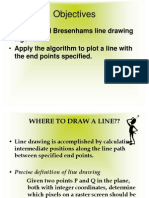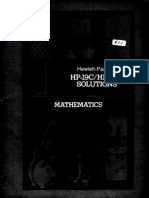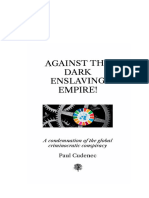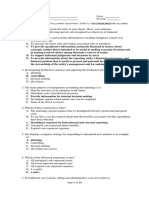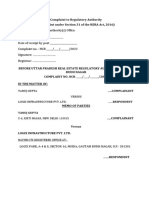Graphics6 BresenhamCirclesAndPolygons
Graphics6 BresenhamCirclesAndPolygons
Uploaded by
Sourabh SharmaCopyright:
Available Formats
Graphics6 BresenhamCirclesAndPolygons
Graphics6 BresenhamCirclesAndPolygons
Uploaded by
Sourabh SharmaOriginal Title
Copyright
Available Formats
Share this document
Did you find this document useful?
Is this content inappropriate?
Copyright:
Available Formats
Graphics6 BresenhamCirclesAndPolygons
Graphics6 BresenhamCirclesAndPolygons
Uploaded by
Sourabh SharmaCopyright:
Available Formats
Computer Graphics 4: Bresenham Line Drawing Algorithm, Circle Drawing & Polygon Filling
Course Website: http://www.comp.dit.ie/bmacnamee
2 of 39
Contents
In todays lecture well have a look at:
Bresenhams line drawing algorithm Line drawing algorithm comparisons Circle drawing algorithms
A simple technique The mid-point circle algorithm
Polygon fill algorithms Summary of raster drawing algorithms
3 of 39
The Bresenham Line Algorithm
The Bresenham algorithm is another incremental scan conversion algorithm The big advantage of this algorithm is that it uses only integer calculations
Jack Bresenham worked for 27 years at IBM before entering academia. Bresenham developed his famous algorithms at IBM in the early 1960s
4 of 39
The Big Idea
Move across the x axis in unit intervals and at each step choose between two different y coordinates For example, from 5 position (2, 3) we (x +1, y +1) have to choose 4 between (3, 3) and (x , y ) 3 (3, 4) (x +1, y ) We would like the 2 point that is closer to 2 3 4 5 the original line
k k k k k k
5 of 39
Deriving The Bresenham Line Algorithm
At sample position xk+1y k+1 the vertical separations y from the mathematical yk line are labelled dupper
dupper dlower
xk+1 and dlower The y coordinate on the mathematical line at xk+1 is:
y = m( xk + 1) + b
6 of 39
Deriving The Bresenham Line Algorithm (cont)
So, dupper and dlower are given as follows:
d lower = y yk = m( xk + 1) + b yk
and:
d upper = ( yk + 1) y
= yk + 1 m( xk + 1) b
We can use these to make a simple decision about which pixel is closer to the mathematical line
7 of 39
Deriving The Bresenham Line Algorithm (cont)
This simple decision is based on the difference between the two pixel positions:
d lower d upper = 2m( xk + 1) 2 yk + 2b 1
Lets substitute m with y/x where x and y are the differences between the end-points:
x(d lower y d upper ) = x(2 ( xk + 1) 2 yk + 2b 1) x
= 2y xk 2x yk + 2y + x(2b 1)
= 2y xk 2x yk + c
8 of 39
Deriving The Bresenham Line Algorithm (cont)
So, a decision parameter pk for the kth step along a line is given by: pk = x(d lower d upper )
= 2y xk 2x yk + c
The sign of the decision parameter pk is the same as that of dlower dupper If pk is negative, then we choose the lower pixel, otherwise we choose the upper pixel
9 of 39
Deriving The Bresenham Line Algorithm (cont)
Remember coordinate changes occur along the x axis in unit steps so we can do everything with integer calculations At step k+1 the decision parameter is given as: pk +1 = 2y xk +1 2x yk +1 + c Subtracting pk from this we get:
pk +1 pk = 2y ( xk +1 xk ) 2x( yk +1 yk )
10 of 39
Deriving The Bresenham Line Algorithm (cont)
But, xk+1 is the same as xk+1 so:
pk +1 = pk + 2y 2x( yk +1 yk )
where yk+1 - yk is either 0 or 1 depending on the sign of pk The first decision parameter p0 is evaluated at (x0, y0) is given as: p0 = 2y x
11 of 39
The Bresenham Line Algorithm
BRESENHAMS LINE DRAWING ALGORITHM (for |m| < 1.0) Input the two line end-points, storing the left end-point in (x0, y0) Plot the point (x0, y0) Calculate the constants x, y, 2y, and (2y - 2x) and get the first value for the decision parameter as:
1. 2. 3.
p0 = 2y x
4.
At each xk along the line, starting at k = 0, perform the following test. If pk < 0, the next point to plot is
(xk+1, yk) and:
pk +1 = pk + 2y
12 of 39
The Bresenham Line Algorithm (cont)
Otherwise, the next point to plot is (xk+1, yk+1) and:
pk +1 = pk + 2y 2x
5. Repeat step 4 (x 1) times
ACHTUNG! The algorithm and derivation above assumes slopes are less than 1. for other slopes we need to adjust the algorithm slightly
13 of 39
Bresenham Example
Lets have a go at this Lets plot the line from (20, 10) to (30, 18) First off calculate all of the constants: x: 10 y: 8 2y: 16 2y - 2x: -4 Calculate the initial decision parameter p0: p0 = 2y x = 6
14 of 39
Bresenham Example (cont)
k pk
(xk+1,yk+1) 0 1 2 3 4 5 6 7 8
20 21 22 23 24 25 26 27 28 29 30
18 17 16 15 14 13 12 11 10
15 of 39
Bresenham Exercise
Go through the steps of the Bresenham line drawing algorithm for a line going from (21,12) to (29,16)
16 of 39
Bresenham Exercise (cont)
k pk
(xk+1,yk+1) 0 1 2 3 4 5 6 7 8
20 21 22 23 24 25 26 27 28 29 30
18 17 16 15 14 13 12 11 10
17 of 39
Bresenham Line Algorithm Summary
The Bresenham line algorithm has the following advantages:
An fast incremental algorithm Uses only integer calculations
Comparing this to the DDA algorithm, DDA has the following problems:
Accumulation of round-off errors can make the pixelated line drift away from what was intended The rounding operations and floating point arithmetic involved are time consuming
18 of 39
A Simple Circle Drawing Algorithm
The equation for a circle is: 2 2 2 x +y =r where r is the radius of the circle So, we can write a simple circle drawing algorithm by solving the equation for y at unit x intervals using:
y = r 2 x2
19 of 39
A Simple Circle Drawing Algorithm (cont)
y0 = 20 2 0 2 20
y1 = 20 2 12 20 y2 = 20 2 2 2 20
y19 = 20 2 19 2 6
y20 = 20 2 20 2 0
20 of 39
A Simple Circle Drawing Algorithm (cont)
However, unsurprisingly this is not a brilliant solution! Firstly, the resulting circle has large gaps where the slope approaches the vertical Secondly, the calculations are not very efficient
The square (multiply) operations The square root operation try really hard to avoid these!
We need a more efficient, more accurate solution
21 of 39
Eight-Way Symmetry
The first thing we can notice to make our circle drawing algorithm more efficient is that circles centred at (0, 0) have eight-way symmetry
(-x, y) (x, y)
(-y, x)
R 2
(y, x)
(-y, -x) (-x, -y)
(y, -x)
(x, -y)
22 of 39
Mid-Point Circle Algorithm
Similarly to the case with lines, there is an incremental algorithm for drawing circles the mid-point circle algorithm In the mid-point circle algorithm we use eight-way symmetry so only ever calculate the points for the top right eighth of a circle, and then use symmetry to get the rest of the points
The mid-point circle algorithm was developed by Jack Bresenham, who we heard about earlier. Bresenhams patent for the algorithm can be viewed here.
23 of 39
Mid-Point Circle Algorithm (cont)
Assume that we have just plotted point (xk, yk)
(xk, yk) (xk+1, yk)
The next point is a choice between (xk+1, yk) and (xk+1, yk-1)
(xk+1, yk-1)
We would like to choose the point that is nearest to the actual circle So how do we make this choice?
24 of 39
Mid-Point Circle Algorithm (cont)
Lets re-jig the equation of the circle slightly to give us: f circ ( x, y ) = x 2 + y 2 r 2 The equation evaluates as follows:
< 0, if ( x, y ) is inside the circle boundary f circ ( x, y ) = 0, if ( x, y ) is on the circle boundary > 0, if ( x, y ) is outside the circle boundary
By evaluating this function at the midpoint between the candidate pixels we can make our decision
25 of 39
Mid-Point Circle Algorithm (cont)
Assuming we have just plotted the pixel at (xk,yk) so we need to choose between (xk+1,yk) and (xk+1,yk-1) Our decision variable can be defined as:
pk = f circ ( xk + 1, yk 1 ) 2 = ( xk + 1) 2 + ( yk 1 ) 2 r 2 2
If pk < 0 the midpoint is inside the circle and and the pixel at yk is closer to the circle Otherwise the midpoint is outside and yk-1 is
26 of 39
Mid-Point Circle Algorithm (cont)
To ensure things are as efficient as possible we can do all of our calculations incrementally First consider:
pk +1 = f circ xk +1 + 1, yk +1 1
2
or:
= [( xk + 1) + 1] + yk +1 1
) 2
pk +1 = pk + 2( xk + 1) + ( y
2 k +1
y ) ( yk +1 yk ) + 1
2 k
where yk+1 is either yk or yk-1 depending on the sign of p
27 of 39
Mid-Point Circle Algorithm (cont)
The first decision variable is given as:
p0 = f circ (1, r 1 ) 2 = 1 + (r 1 ) 2 r 2 2 = 5 r 4
Then if pk < 0 then the next decision variable is given as:
pk +1 = pk + 2 xk +1 + 1
If pk > 0 then the decision variable is:
pk +1 = pk + 2 xk +1 + 1 2 yk + 1
28 of 39
The Mid-Point Circle Algorithm
MID-POINT CIRCLE ALGORITHM Input radius r and circle centre (xc, yc), then set the coordinates for the first point on the circumference of a circle centred on the origin as:
( x0 , y0 ) = (0, r )
Calculate the initial value of the decision parameter as:
p0 = 5 r 4
Starting with k = 0 at each position xk, perform the following test. If pk < 0, the next point along the circle centred on (0, 0) is (xk+1, yk) and:
pk +1 = pk + 2 xk +1 + 1
29 of 39
The Mid-Point Circle Algorithm (cont)
Otherwise the next point along the circle is (xk+1, yk-1) and:
pk +1 = pk + 2 xk +1 + 1 2 yk +1
4. 5. Determine symmetry points in the other seven octants Move each calculated pixel position (x, y) onto the circular path centred at (xc, yc) to plot the coordinate values:
x = x + xc
6.
y = y + yc
Repeat steps 3 to 5 until x >= y
30 of 39
Mid-Point Circle Algorithm Example
To see the mid-point circle algorithm in action lets use it to draw a circle centred at (0,0) with radius 10
31 of 39
Mid-Point Circle Algorithm Example (cont)
k 0 1 2 3 4 5 6
0 1 2 3 4 5 6 7 8 9 10
10 9 8 7 6 5 4 3 2 1 0
pk
(xk+1,yk+1)
2xk+1
2yk+1
32 of 39
Mid-Point Circle Algorithm Exercise
Use the mid-point circle algorithm to draw the circle centred at (0,0) with radius 15
33 of 39 16 15 14 13 12 11 10 9 8 7 6 5 4 3 2 1 0
Mid-Point Circle Algorithm Example (cont)
k
0 1 2 3 4 5 6 7 8 9 10 11 12
pk
(xk+1,yk+1)
2xk+1
2yk+1
0 1 2 3 4 5 6 7 8 9 10 11 12 13 14 15 16
34 of 39
Mid-Point Circle Algorithm Summary
The key insights in the mid-point circle algorithm are:
Eight-way symmetry can hugely reduce the work in drawing a circle Moving in unit steps along the x axis at each point along the circles edge we need to choose between two possible y coordinates
35 of 39
Filling Polygons
So we can figure out how to draw lines and circles How do we go about drawing polygons? We use an incremental algorithm known as the scan-line algorithm
36 of 39 10
Scan-Line Polygon Fill Algorithm
Scan Line
10
12
14
16
37 of 39
Scan-Line Polygon Fill Algorithm
The basic scan-line algorithm is as follows:
Find the intersections of the scan line with all edges of the polygon Sort the intersections by increasing x coordinate Fill in all pixels between pairs of intersections that lie interior to the polygon
38 of 39
Scan-Line Polygon Fill Algorithm (cont)
39 of 39
Line Drawing Summary
Over the last couple of lectures we have looked at the idea of scan converting lines The key thing to remember is this has to be FAST For lines we have either DDA or Bresenham For circles the mid-point algorithm
40 of 39
Anti-Aliasing
41 of 39
Summary Of Drawing Algorithms
42 of 39
Mid-Point Circle Algorithm (cont)
6
3 1 2 3 4
43 of 39
Mid-Point Circle Algorithm (cont)
6 M 5
3 1 2 3 4
44 of 39
Mid-Point Circle Algorithm (cont)
6
M
5
3 1 2 3 4
45 of 39
Blank Grid
46 of 39
Blank Grid
47 of 39
Blank Grid
10 9 8 7 6 5 4 3 2 1 0 0 1 2 3 4 5 6 7 8 9 10
48 of 39
Blank Grid
You might also like
- Concise Guide For CHALR ExaminationDocument6 pagesConcise Guide For CHALR ExaminationSrinivasa Rao83% (6)
- Cgsem 4 PPT 2Document50 pagesCgsem 4 PPT 2Piyush RaghavNo ratings yet
- Bresenham Line Drawing Algorithm, Circle Drawing & Polygon FillingDocument50 pagesBresenham Line Drawing Algorithm, Circle Drawing & Polygon FillingMidhun ChakravarthyNo ratings yet
- The Bresenham Line AlgorithmDocument15 pagesThe Bresenham Line AlgorithmsyedabdulkarimNo ratings yet
- Line Drawing AlgoDocument19 pagesLine Drawing AlgoArihant JainNo ratings yet
- Brese Nham Circles and PolygonsDocument59 pagesBrese Nham Circles and PolygonsgetchewNo ratings yet
- CG Unit-1 Line Drawing AlgsDocument29 pagesCG Unit-1 Line Drawing Algssrinu bNo ratings yet
- Computer Graphics: Bresenham Line Drawing Algorithm, Circle Drawing & Polygon FillingDocument56 pagesComputer Graphics: Bresenham Line Drawing Algorithm, Circle Drawing & Polygon Fillinghumtum_amarNo ratings yet
- Computer Graphics 4: Bresenham Line Drawing Algorithm, Circle Drawing & Polygon FillingDocument48 pagesComputer Graphics 4: Bresenham Line Drawing Algorithm, Circle Drawing & Polygon FillingareejalmajedNo ratings yet
- 2 DDA - Line DrawingDocument6 pages2 DDA - Line DrawingAnmolDhillonNo ratings yet
- DDA & BRESENHAMS, Circle (Mid Point Approch)Document36 pagesDDA & BRESENHAMS, Circle (Mid Point Approch)varunmundaleNo ratings yet
- Lecture 4 Scan Conversion Bresenhams AlgorithmDocument16 pagesLecture 4 Scan Conversion Bresenhams AlgorithmDyuti IslamNo ratings yet
- 2.raster Scan AlgoDocument83 pages2.raster Scan AlgoYashovardhan BangurNo ratings yet
- Bresenham: Circle Drawing AlgorithmDocument31 pagesBresenham: Circle Drawing AlgorithmRaju RanjanNo ratings yet
- Bresenham Line Drawing Algorithm,: Course WebsiteDocument47 pagesBresenham Line Drawing Algorithm,: Course Websitejontyrhodes1012237No ratings yet
- Lecture-5 (Bresenhams Line Problems)Document47 pagesLecture-5 (Bresenhams Line Problems)jontyrhodes1012237No ratings yet
- CH3 GRAP LectureDocument49 pagesCH3 GRAP LecturepyramidmistreNo ratings yet
- Line Generation AlgorithmsDocument60 pagesLine Generation AlgorithmsJohnNo ratings yet
- Lecture 4 Scan Conversion Bresenhams AlgorithmDocument16 pagesLecture 4 Scan Conversion Bresenhams AlgorithmAtik Israk LemonNo ratings yet
- Cad/Cam: Rasterisation Scan Conversion of LinesDocument34 pagesCad/Cam: Rasterisation Scan Conversion of LinesDeepak AwasthiNo ratings yet
- Graphics Lecture 03Document33 pagesGraphics Lecture 03ebnahmed1112No ratings yet
- Computer GraphicsDocument25 pagesComputer Graphicsxixoyi3396No ratings yet
- Chap 1Document22 pagesChap 1RESHMA FEGADENo ratings yet
- Raster Scan GraphicsDocument39 pagesRaster Scan GraphicsprashaherNo ratings yet
- 2.raster Scan AlgoDocument83 pages2.raster Scan AlgoPrachit YelamkarNo ratings yet
- MidPointCircle DrawingDocument43 pagesMidPointCircle DrawingMazharulislamNo ratings yet
- Bresenham N Circle AlgorithmDocument21 pagesBresenham N Circle AlgorithmSOWMYANo ratings yet
- Line Drawing Algorithms: y MX + B B The y Intercept of A LineDocument23 pagesLine Drawing Algorithms: y MX + B B The y Intercept of A LineKrishan Pal Singh RathoreNo ratings yet
- CG CH3 Scan Conversion2Document53 pagesCG CH3 Scan Conversion2Nardos TesemaNo ratings yet
- Computer Graphics Notes-WatermarkDocument55 pagesComputer Graphics Notes-WatermarkEr. Ramji TripathiNo ratings yet
- The Bresenham Line AlgorithmDocument7 pagesThe Bresenham Line AlgorithmBEKAN FAYERANo ratings yet
- Implementation Algorithms For Graphics Primitives and AttributesDocument27 pagesImplementation Algorithms For Graphics Primitives and AttributesDavid AdeolaNo ratings yet
- Bressenham's Algorithm Easily ExplainedDocument18 pagesBressenham's Algorithm Easily ExplainedXenulhassanNo ratings yet
- Points, Lines, Circles and Ellipses As Primitives, Conversion Algorithms For PrimitivesDocument26 pagesPoints, Lines, Circles and Ellipses As Primitives, Conversion Algorithms For Primitivesn9166254105No ratings yet
- Computer Graphics Circle Drawing TechniquesDocument45 pagesComputer Graphics Circle Drawing TechniquesNusrat UllahNo ratings yet
- Bresenhams Circle AlgDocument31 pagesBresenhams Circle Algombadgujar33No ratings yet
- Computer GraphicsDocument18 pagesComputer GraphicsSUKHWINDER SINGHNo ratings yet
- Scan Converting CircleDocument36 pagesScan Converting CircleKashish KansalNo ratings yet
- Bresenham Line Drawing AlgorithmDocument14 pagesBresenham Line Drawing AlgorithmthirumalaikumaranNo ratings yet
- Unit-1.2.4 Mid-Point Circle DrawingDocument21 pagesUnit-1.2.4 Mid-Point Circle Drawing20BCA1382 GYAN VARDHANNo ratings yet
- Module 2Document16 pagesModule 2maheswaranoop08No ratings yet
- Computer Grapics Chapter 2 Note 1Document19 pagesComputer Grapics Chapter 2 Note 1ErmiasNo ratings yet
- Lecture03 GraphicsPrimitivesDocument66 pagesLecture03 GraphicsPrimitivesBeer ThunradaNo ratings yet
- Circle Drawing AlgorithmDocument26 pagesCircle Drawing AlgorithmSatyam KrishnaNo ratings yet
- Where To Draw A Line??Document49 pagesWhere To Draw A Line??RajaRaman.GNo ratings yet
- Bresenham AlgorithmDocument28 pagesBresenham Algorithmakila Peter100% (1)
- Chapter IIDocument5 pagesChapter IIabenezer g/kirstosNo ratings yet
- Unit-3 Scan Line Conversion AlgorithmDocument25 pagesUnit-3 Scan Line Conversion AlgorithmBinod AdhikariNo ratings yet
- Chapter 3Document40 pagesChapter 3beki BANo ratings yet
- Advantage & Disadvantage of DDA AlgoDocument19 pagesAdvantage & Disadvantage of DDA AlgoJoyal GeorgeNo ratings yet
- Computer Graphics: (CODE: ECS-504)Document23 pagesComputer Graphics: (CODE: ECS-504)Disha KukrejaNo ratings yet
- Computer Graphics (CSE-435) : Lecture-1Document51 pagesComputer Graphics (CSE-435) : Lecture-1Mohammad Wasi IbtidaNo ratings yet
- Mod-2, Bresenhams Line Drawing AlgorithmDocument16 pagesMod-2, Bresenhams Line Drawing AlgorithmSachin Varghese0% (1)
- Line, Circle, EllipseDocument8 pagesLine, Circle, Ellipsepriskilla SelvinNo ratings yet
- IT6501 Notes RejinpaulDocument109 pagesIT6501 Notes RejinpaulSuraj KumarNo ratings yet
- Chapter 2Document19 pagesChapter 2alexsabebe28No ratings yet
- Submitted To Submitted by Kunal Malik 4002: DR - Kiran Malik AP (CSE Dept.)Document43 pagesSubmitted To Submitted by Kunal Malik 4002: DR - Kiran Malik AP (CSE Dept.)Kunal MalikNo ratings yet
- Chapter 3 - Part 1 (Autosaved)Document38 pagesChapter 3 - Part 1 (Autosaved)Ad ManNo ratings yet
- A Brief Introduction to MATLAB: Taken From the Book "MATLAB for Beginners: A Gentle Approach"From EverandA Brief Introduction to MATLAB: Taken From the Book "MATLAB for Beginners: A Gentle Approach"Rating: 2.5 out of 5 stars2.5/5 (2)
- HP-19C & 29C Solutions Mathematics 1977 B&WDocument40 pagesHP-19C & 29C Solutions Mathematics 1977 B&WjjirwinNo ratings yet
- Parameter Optimization in Image Enhancement Using PSODocument7 pagesParameter Optimization in Image Enhancement Using PSOAJER JOURNALNo ratings yet
- Against The Dark Enslaving Empire OnlineDocument328 pagesAgainst The Dark Enslaving Empire OnlineisabelNo ratings yet
- The Golden CalfDocument55 pagesThe Golden CalfGilles ReginaldNo ratings yet
- Del Mar Vs PAGCOR - Case DigestDocument2 pagesDel Mar Vs PAGCOR - Case DigestJane MaribojoNo ratings yet
- Thin Client DXR-Z4 Datasheet DS-RZR4-0001 2.0 January 2022Document2 pagesThin Client DXR-Z4 Datasheet DS-RZR4-0001 2.0 January 2022AdrianiNo ratings yet
- Case Study SolutionDocument6 pagesCase Study Solutionsamyak60% (5)
- Supply Chain Management Disaster at NikeDocument4 pagesSupply Chain Management Disaster at NikePrateek Goel86% (7)
- Sale Cheat Sheet by MySmartPrice - Com - Updated HourlyDocument9 pagesSale Cheat Sheet by MySmartPrice - Com - Updated HourlySiva ChandranNo ratings yet
- PE Lecture No.05Document7 pagesPE Lecture No.05islammuddinNo ratings yet
- Python Numpy Pandas Interview QuestionsDocument8 pagesPython Numpy Pandas Interview QuestionsKinjal GoswamiNo ratings yet
- Solution Ecom30004 Homework2 Questions-1Document6 pagesSolution Ecom30004 Homework2 Questions-1AhmEd GhayasNo ratings yet
- BodyDocument5 pagesBodyGilbert RomeroNo ratings yet
- Dhaval DisertationDocument35 pagesDhaval DisertationRaviraj MalaniNo ratings yet
- Wsfsn-2024 Tentative ProgramDocument4 pagesWsfsn-2024 Tentative ProgramworldsummitonfoodscienceNo ratings yet
- MAS MIDTERM EXAM 1ST SEM AY2017-18 - With AnswersDocument19 pagesMAS MIDTERM EXAM 1ST SEM AY2017-18 - With AnswersUy Samuel100% (1)
- Rer A Complaint T Anuj GuptaDocument15 pagesRer A Complaint T Anuj GuptaAryan SrivastavaNo ratings yet
- Fabrication of Automatic Spring Rolling MachineDocument66 pagesFabrication of Automatic Spring Rolling MachineVinayaga ProjectinstituteNo ratings yet
- Oil Extend Roto FluidDocument2 pagesOil Extend Roto Fluidaryluck77No ratings yet
- XC802100 ManualDocument68 pagesXC802100 Manualedgardogarcia085No ratings yet
- 1 BTQS3024 (2023) - Week1A (Intro)Document34 pages1 BTQS3024 (2023) - Week1A (Intro)JIA WEI SIEWNo ratings yet
- Preventive Action ProcedureDocument1 pagePreventive Action ProcedureZharel AhmadNo ratings yet
- Odero,., Brian Jacks MSC Civil and Structural Engineering 2016Document135 pagesOdero,., Brian Jacks MSC Civil and Structural Engineering 2016amosomwega21No ratings yet
- Accounting For Special TransactionsDocument11 pagesAccounting For Special Transactionsjohn carloNo ratings yet
- Biological ModelDocument10 pagesBiological ModelHoney-Zeth TalaveraNo ratings yet
- c16d The Lintner Model of PayoutDocument3 pagesc16d The Lintner Model of PayoutvavnishNo ratings yet
- Pure Sine Vawe Inverter: SHI SeriesDocument3 pagesPure Sine Vawe Inverter: SHI SeriesbehaosziNo ratings yet
- Maths Homework Booklet Year 1Document4 pagesMaths Homework Booklet Year 1axnybeapd100% (1)
- Chapter 4 Warm UpsDocument4 pagesChapter 4 Warm Upsapi-259543534No ratings yet




















































